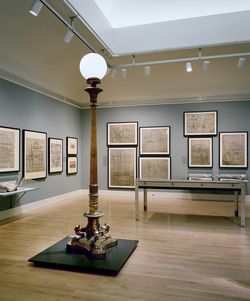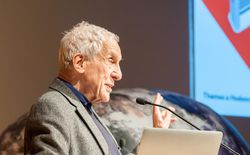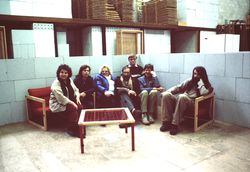This exhibition looks at the transformation of Montréal from a nineteenth century merchant city to the metropolis of Canada. It examines the elements that made Montréal a political, social, and economic centre and explores the unique character of its architecture. The exhibition brings together some 350 objects, including drawings from the CCA collection by Montréal(...)
Main galleries
18 March 1998 to 24 May 1998
Montréal Métropole, 1880–1930
Actions:
Description:
This exhibition looks at the transformation of Montréal from a nineteenth century merchant city to the metropolis of Canada. It examines the elements that made Montréal a political, social, and economic centre and explores the unique character of its architecture. The exhibition brings together some 350 objects, including drawings from the CCA collection by Montréal(...)
Main galleries
Small black address book
PHCON2002:0016:021:003
Description:
Address book documents the addresses of friends and colleagues of Gordon Matta-Clark from the period of his activity as an artist/architect. Much of the information is duplicated from his large black address book (PHCON2002:0016:021:002), suggesting perhaps that this smaller book was used on trips outside New York City, New York. Address book is arranged alphabetically.
1970-1978
Small black address book
Actions:
PHCON2002:0016:021:003
Description:
Address book documents the addresses of friends and colleagues of Gordon Matta-Clark from the period of his activity as an artist/architect. Much of the information is duplicated from his large black address book (PHCON2002:0016:021:002), suggesting perhaps that this smaller book was used on trips outside New York City, New York. Address book is arranged alphabetically.
1970-1978
Project
Tasmania Beach Party, Hobart
AP144.S2.D11
Description:
File documents an experimental project undertaken as part of the AASA Convention of Creativity hosted in Hobart, Australia. Three diagrammatic plans document how people worked on the beach site during a three hour period. Annotated versions of these drawings were published in "The First Installment in the Cedric Price Series." 'Architectural Design'. vol. 40, (October 1970), 511. Material in this file was produced in 1968. File contains schematic drawings.
[1968]
Tasmania Beach Party, Hobart
Actions:
AP144.S2.D11
Description:
File documents an experimental project undertaken as part of the AASA Convention of Creativity hosted in Hobart, Australia. Three diagrammatic plans document how people worked on the beach site during a three hour period. Annotated versions of these drawings were published in "The First Installment in the Cedric Price Series." 'Architectural Design'. vol. 40, (October 1970), 511. Material in this file was produced in 1968. File contains schematic drawings.
File 11
[1968]
In this conversation, Kenneth Frampton (Columbia University) will discuss approaches to architectural history today with Esra Akcan (Cornell University) and Mark Jarzombek (Massachusetts Institute of Technology). What does it mean to write a global history of architecture now? What is the relationship between such a history and urgent contemporary concerns? During a(...)
6 April 2017
A Conversation with Kenneth Frampton: Can There Be a Global Architectural History Today?
Actions:
Description:
In this conversation, Kenneth Frampton (Columbia University) will discuss approaches to architectural history today with Esra Akcan (Cornell University) and Mark Jarzombek (Massachusetts Institute of Technology). What does it mean to write a global history of architecture now? What is the relationship between such a history and urgent contemporary concerns? During a(...)
Project
AP001.S6.1924.PR04
Description:
La construction de l’Université de Montréal s’est effectuée sur plusieurs années. Cormier est architecte en chef entre 1924 et 1947 et agit à titre d’architecte-conseil et d’ingénieur-conseil entre 1950 et 1961. Il semblait inévitable de diviser le cadre de classement en deux phases pour bien distinguer le rôle et l’implication de Cormier qui diffère durant ces deux périodes. La présence de deux plans d’ensembles très différents proposés en 1931 et 1961 appuie cette décision. Cette première phase s’étend sur une aussi longue période puisque le processus de construction a été parsemé de problèmes logistiques et financiers. Dès le début des travaux, le sol cause des problèmes lors de l’excavation et engendre des coûts supplémentaires en plus de retarder le processus. Avec la crise financière qui frappe en 1929, les travaux sont progressivement stoppés. De plus, les conditions météorologiques vont endommager une partie de la toiture et de la maçonnerie qui avait déjà été entamée, ce qui vient encore une fois engendrer des coûts additionnels. Suite au contexte économique particulier, l’administration de l’UdeM demande l’aide financière du gouvernement provincial pour protéger ce qui avait déjà été construit du pavillon principal. Le bâtiment sera finalement repris en 1943 et inauguré en 1947. Suite aux nombreux problèmes qui parsèmeront la première phase, le plan initial proposé par Cormier qui comprenait un stade, un aréna et la maison des animaux, sera abandonné au détriment du pavillon principal. Les projets non-réalisés sont tout de même documenté dans leurs sous-séries respectives. Il est important de prendre note que les plans produits par Cormier concernant les ailes du pavillon principal qui allaient servir de Centre Hospitalier ne seront jamais réalisés. Différents départements vont plutôt occuper l’espace.
1924-1947
Université de Montréal - Phase 1
Actions:
AP001.S6.1924.PR04
Description:
La construction de l’Université de Montréal s’est effectuée sur plusieurs années. Cormier est architecte en chef entre 1924 et 1947 et agit à titre d’architecte-conseil et d’ingénieur-conseil entre 1950 et 1961. Il semblait inévitable de diviser le cadre de classement en deux phases pour bien distinguer le rôle et l’implication de Cormier qui diffère durant ces deux périodes. La présence de deux plans d’ensembles très différents proposés en 1931 et 1961 appuie cette décision. Cette première phase s’étend sur une aussi longue période puisque le processus de construction a été parsemé de problèmes logistiques et financiers. Dès le début des travaux, le sol cause des problèmes lors de l’excavation et engendre des coûts supplémentaires en plus de retarder le processus. Avec la crise financière qui frappe en 1929, les travaux sont progressivement stoppés. De plus, les conditions météorologiques vont endommager une partie de la toiture et de la maçonnerie qui avait déjà été entamée, ce qui vient encore une fois engendrer des coûts additionnels. Suite au contexte économique particulier, l’administration de l’UdeM demande l’aide financière du gouvernement provincial pour protéger ce qui avait déjà été construit du pavillon principal. Le bâtiment sera finalement repris en 1943 et inauguré en 1947. Suite aux nombreux problèmes qui parsèmeront la première phase, le plan initial proposé par Cormier qui comprenait un stade, un aréna et la maison des animaux, sera abandonné au détriment du pavillon principal. Les projets non-réalisés sont tout de même documenté dans leurs sous-séries respectives. Il est important de prendre note que les plans produits par Cormier concernant les ailes du pavillon principal qui allaient servir de Centre Hospitalier ne seront jamais réalisés. Différents départements vont plutôt occuper l’espace.
Project
1924-1947
drawings, textual records, photographs
ARCH169115
Description:
60 feuillets: Correspondance et documentation relatives à la participation de Jacques Rousseau au projet d'exposition "Water Works" organisé par Visual Arts Ontario décembre 1987-septembre 1988 jusqu'à 35,5 x 21,5 cm 1 carte postale 1 facture "Rent-a-Wreck" 1 carte d'affaire 2 billets d'avion 1 périodique: ArtViews, été 1987, vol.13, no.3 6 feuillets: Coupures de journaux et photocopies 35,5 x 21,5 cm Plan d'une section du rivage du Lac Ontario
Correspondance et documentation relatives au projet d'exposition "Water Works"
Actions:
ARCH169115
Description:
60 feuillets: Correspondance et documentation relatives à la participation de Jacques Rousseau au projet d'exposition "Water Works" organisé par Visual Arts Ontario décembre 1987-septembre 1988 jusqu'à 35,5 x 21,5 cm 1 carte postale 1 facture "Rent-a-Wreck" 1 carte d'affaire 2 billets d'avion 1 périodique: ArtViews, été 1987, vol.13, no.3 6 feuillets: Coupures de journaux et photocopies 35,5 x 21,5 cm Plan d'une section du rivage du Lac Ontario
drawings, textual records, photographs
archives
Level of archival description:
Fonds
Bernard Cache fonds
AP169
Synopsis:
Bernard Cache, fonds, 1991-2011, document the development and design process for the Objectile firm and its decorative panels and furniture. The records focus mostly on daily activities of the firm, the collaboration of principal Bernard Cache with TopSolid software, and his parallel academic work. The records consist solely of original born-digital material.
1992-2011
Bernard Cache fonds
Actions:
AP169
Synopsis:
Bernard Cache, fonds, 1991-2011, document the development and design process for the Objectile firm and its decorative panels and furniture. The records focus mostly on daily activities of the firm, the collaboration of principal Bernard Cache with TopSolid software, and his parallel academic work. The records consist solely of original born-digital material.
archives
Level of archival description:
Fonds
1992-2011
Following an intense period of work in the mid-1970s with Portugal’s post-revolutionary housing initiatives, in the early 1980s Álvaro Siza contributed projects to two of the most important urban renewal programs in Europe: Berlin’s IBA and The Hague’s Stadsvernieuwing als Kulturel Aktiviteit (Urban Renewal as a Cultural Activity). This lecture will examine the(...)
26 November 2015
Álvaro Siza’s Archaeology of the Ordinary
Actions:
Description:
Following an intense period of work in the mid-1970s with Portugal’s post-revolutionary housing initiatives, in the early 1980s Álvaro Siza contributed projects to two of the most important urban renewal programs in Europe: Berlin’s IBA and The Hague’s Stadsvernieuwing als Kulturel Aktiviteit (Urban Renewal as a Cultural Activity). This lecture will examine the(...)
Visiting Scholar Irene Sunwoo presents her research: During the 1970s and 1980s, the Architectural Association (AA) in London tested a “marketplace” model of architectural education that supported an array of theoretical investigations. Exploring issues including politics, phenomenology, semiotics, sustainability, literature, and third-world housing, the school became a(...)
Shaughnessy House
27 July 2017, 6pm
Visiting Scholar Seminar: Irene Sunwoo
Actions:
Description:
Visiting Scholar Irene Sunwoo presents her research: During the 1970s and 1980s, the Architectural Association (AA) in London tested a “marketplace” model of architectural education that supported an array of theoretical investigations. Exploring issues including politics, phenomenology, semiotics, sustainability, literature, and third-world housing, the school became a(...)
Shaughnessy House
Sub-series
AP156.S1.SS2
Description:
Cette sous-série contient la correspondance, envoyée et reçu, de Pierre Jeanneret, avec les correspondants suivants: Georges Blanchon, Lola Blanchon, Eulie Chowdhury, Dominique Escorsa, Lucien Hervé, Le Corbusier, Jeet Malhotra, Charlotte Perriand, Jean Prouvé, Mohinder Singh Randhawa, et S. Vohra. La correspondence couvrent la période de 1924 à 1970. This sub-series contains correspondence between Pierre Jeanneret and the following individuals: Georges Blanchon, Lola Blanchon, Eulie Chowdhury, Dominique Escorsa, Lucien Hervé, Le Corbusier, Jeet Malhotra, Charlotte Perriand, Jean Prouvé, Mohinder Singh Randhawa, and S. Vohra. The correspondence dates between 1924 and 1970.
1924-1970
Correspondants particuliers de Pierre Jeanneret (reçue et envoyée) = Particular correspondents of Pierre Jeanneret (sent and received)
Actions:
AP156.S1.SS2
Description:
Cette sous-série contient la correspondance, envoyée et reçu, de Pierre Jeanneret, avec les correspondants suivants: Georges Blanchon, Lola Blanchon, Eulie Chowdhury, Dominique Escorsa, Lucien Hervé, Le Corbusier, Jeet Malhotra, Charlotte Perriand, Jean Prouvé, Mohinder Singh Randhawa, et S. Vohra. La correspondence couvrent la période de 1924 à 1970. This sub-series contains correspondence between Pierre Jeanneret and the following individuals: Georges Blanchon, Lola Blanchon, Eulie Chowdhury, Dominique Escorsa, Lucien Hervé, Le Corbusier, Jeet Malhotra, Charlotte Perriand, Jean Prouvé, Mohinder Singh Randhawa, and S. Vohra. The correspondence dates between 1924 and 1970.
Sous-série 2
1924-1970



